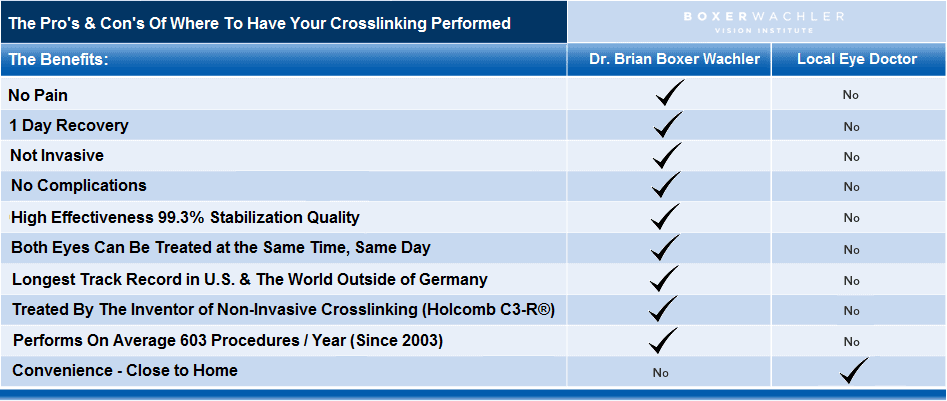(Epi-On) Cross-Linking in Los Angeles
Does Corneal Epithelium Need To Be Removed for Corneal Cross Linking?
Absolutely not. We have been performing cross-linking with intact epithelium (called “epi-on”) since 2003 in the United States and still continue to do so. Many doctors around the world have now adopted this technique. Prominent ophthalmologists Dr. Roberto Pinelli in Italy and Dr. Colin Chan in Australia were personally taught Dr. Brian’s Holcomb C3-R® and are seeing excellent results. Dr. Brian received the 2010 Jules Stein Living Tribute Award for performing Holcomb C3-R® Cross linking System on U.S. Bobsled Driver Steve Holcomb that helped restore his vision enabling him to win the Gold Medal in 2010 in Vancouver – this was the first Gold Medal for the United States in bobsled in 62 years.
My Doctor Says The Epithelium Must Be Removed For Cross-Linking To Work
This opinion is probably based on a flawed laboratory study in pig eyes that concluded that riboflavin does not penetrate into the cornea through the epithelium. Dr. Brian and colleagues published a letter to the editor pointing out the multiple flaws in the study. Having earned a world-class reputation as a leader and pioneer in ophthalmology, Dr. Brian would not continue to do the Holcomb C3-R® Cross-Linking System if it didn’t work!
Why Do Doctors Say To Remove The Epithelium For Riboflavin Penetration?
The reason that some doctors say riboflavin does not penetrate the cornea with intact epithelium is that they are using the wrong solution with the riboflavin for it to penetrate. They are using a very thick mixture of Dextran and Riboflavin that has a consistency similar to that of molasses or honey. This molasses-like Dextran carrier holds onto Riboflavin so it can’t penetrate through the epithelium. The correct riboflavin solution for the Holcomb C3-R® Cross-linking System is one that has the consistency of water. This thin mixture allows our proprietary Cross Linking Solution (that contains riboflavin and other compounds) to penetrate into the cornea without disrupting the epithelium.
This is the explanation for differing opinions of the Holcomb C3-R® Cross Linking System. Wrong solution = the wrong result. If you don’t use the right engine oil in a race car, the car won’t run well. The correct solution must be used for Holcomb C3-R®. Also if the Holcomb C3-R® Cross-Linking System didn’t work, then the United States wouldn’t have its first Gold Medal in 4 Man Bobsled in 62 years!
Patients Describe Epi-Off Cross-Linking in One Eye and Holcomb C3-R® in Other Eye
Out Of Town Eye Patients – Complimentary Record / Photo Review
In our practice 58% of keratoconus patients travel from out of town (including out of state and out of the country). If you are interested, Dr. Brian can provide a complimentary record review prior to you scheduling an appointment at the institute. This will not only help to determine initial candidacy but also provide you with an estimate of pricing to help you prepare financially for the trip.
Records Review for Vision Correction and Keratoconus Procedures
A records review (for vision correction or Keratoconus procedures) is easy and the first step to improving your life. Here’s how to submit them to Dr. Brian:
Scan & E-mail
Sending By Mail
Boxer Wachler Vision Institute
ATTN: Records Review
465 N. Roxbury Drive, Suite 902
Beverly Hills, CA 90210

















